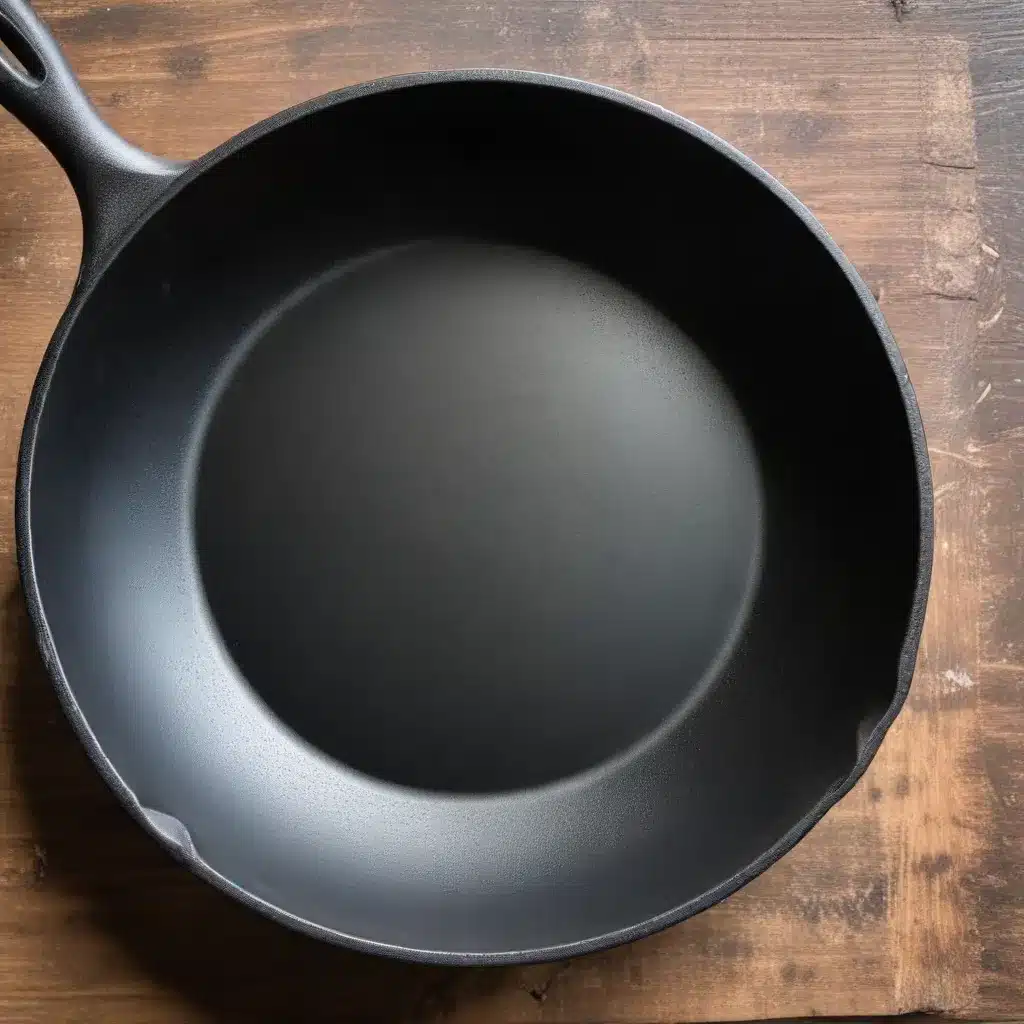
As a seasoned culinary professional, I’ve had the pleasure of working with various kitchen tools and equipment, but nothing quite compares to the versatility and durability of a well-seasoned cast iron skillet. These trusty companions can last for generations, withstanding the test of time and intense cooking sessions, but they do require some special care to maintain their signature nonstick finish and prevent rusting.
In this comprehensive guide, I’ll share my expert insights and practical tips on how to revive and resurface your cast iron skillet, ensuring it looks and performs like new. Whether your skillet has suffered from years of wear and tear, or you’ve recently acquired a vintage piece in need of some TLC, this article will equip you with the knowledge and techniques to bring it back to its former glory.
Understanding the Importance of Cast Iron Skillet Resurfacing
Cast iron skillets are prized for their exceptional heat retention, even cooking, and ability to develop a natural, nonstick patina over time. This seasoning, or polymerized oil coating, is what gives cast iron its signature smooth finish and protects the surface from rusting.
However, even the most well-cared-for cast iron can succumb to damage, such as chipping, flaking, or pitting of the seasoning. When this happens, the skillet becomes more difficult to clean, food is more likely to stick, and the risk of rust increases.
Proper resurfacing is crucial to restoring the skillet’s performance and ensuring its longevity. By stripping away the damaged seasoning and rebuilding a new, uniform layer, you can revitalize your cast iron skillet and unlock its full potential for a lifetime of exceptional cooking.
Assessing the Condition of Your Cast Iron Skillet
Before embarking on the resurfacing process, it’s important to carefully inspect your cast iron skillet and determine the extent of the damage. This will help you understand the level of effort required and the necessary steps to achieve the desired result.
Look for the following signs of wear and tear:
- Chipping or Flaking Seasoning: If you notice any areas where the seasoning has chipped or flaked off, this is a clear indication that resurfacing is required.
- Pitting or Rusting: Pits or rust spots on the surface of the skillet can compromise the nonstick properties and lead to further deterioration if left untreated.
- Discoloration or Uneven Patina: An uneven or discolored seasoning can signify that the skillet has not been properly maintained or is in need of a refresh.
Once you’ve identified the areas of concern, you can proceed with the resurfacing process, tailoring your approach to address the specific issues with your cast iron skillet.
Preparing Your Cast Iron Skillet for Resurfacing
Before you can begin the resurfacing process, you’ll need to thoroughly clean and strip the existing seasoning from the skillet. This step is crucial, as any remaining residue or impurities can interfere with the formation of a new, uniform layer of seasoning.
Stripping the Existing Seasoning
There are several methods you can use to remove the old seasoning, depending on the extent of the damage and your personal preferences:
-
Oven Cleaning Method: Place the cast iron skillet in a self-cleaning oven cycle, which will reach temperatures high enough to burn off the existing seasoning. This method is effective but can be time-consuming, as the full cleaning cycle can take several hours.
-
Lye-Based Oven Cleaner: Apply a lye-based oven cleaner to the skillet, let it sit for the recommended time, and then scrub away the softened seasoning. This approach is more hands-on but can be quite effective.
-
Sanding or Abrasive Cleaning: Use sandpaper, steel wool, or a wire brush to mechanically remove the damaged seasoning. This method requires more elbow grease but allows for precise control over the resurfacing process.
Whichever method you choose, be sure to thoroughly clean the skillet with hot, soapy water and a stiff-bristle brush to remove any remaining seasoning or cleaning residue. Dry the skillet completely before moving on to the next step.
Restoring the Skillet’s Surface
Once the skillet is stripped of its old seasoning, it’s time to address any surface imperfections or damage. This may involve the following steps:
-
Smoothing Out Pits or Uneven Areas: Use fine-grit sandpaper or an abrasive pad to gently smooth out any pits, scratches, or uneven areas on the surface of the skillet. Be careful not to over-sand, as this can thin the metal and compromise the skillet’s durability.
-
Removing Rust: If there are any rust spots on the skillet, use a steel wool pad or a wire brush to remove them, ensuring the surface is clean and smooth.
-
Seasoning the Skillet: After cleaning and prepping the surface, you’ll need to build up a new, uniform layer of seasoning. This involves coating the skillet with a thin layer of high-heat-resistant oil, such as vegetable, canola, or grapeseed oil, and baking it in the oven at a high temperature to polymerize the oil and create a nonstick finish.
For best results, apply multiple coats of seasoning, allowing the skillet to cool completely between each application.
By taking the time to properly prepare the surface of your cast iron skillet, you’ll set the stage for a flawless resurfacing that will reward you with years of exceptional cooking performance.
Mastering the Resurfacing Technique
With your cast iron skillet properly prepared, it’s time to put your resurfacing skills to the test. This process may require some trial and error, but with practice, you’ll soon develop the confidence and technique to achieve a professional-grade finish.
Applying a Base Coat of Seasoning
Begin by applying a generous, even coating of your chosen high-heat oil to the entire surface of the skillet, including the sidewalls and the bottom. Make sure to cover every inch, as this base layer will be crucial for building up the new seasoning.
Once the oil is applied, place the skillet in a preheated oven at around 400°F (200°C) and let it bake for approximately 1 hour. This high-heat treatment will cause the oil to polymerize and create a durable, nonstick foundation.
Successive Seasoning Layers
After the initial baking, you’ll want to repeat the seasoning process, applying a thin, even coat of oil and then baking the skillet again. Depending on the condition of your skillet, you may need to do this 3-5 times to build up a strong, uniform seasoning layer.
The key to successful resurfacing is patience and attention to detail. Take your time, ensuring each layer of seasoning is properly applied and cured before moving on to the next. This will help create a smooth, glossy finish that will last for years to come.
Maintaining the Resurfaced Finish
Once you’ve achieved the desired level of resurfacing, it’s crucial to properly maintain your cast iron skillet to preserve its nonstick properties and prevent future damage.
Here are some tips for ongoing care:
- Avoid Soap: When cleaning your cast iron, use hot water and a stiff-bristle brush or scrub pad, avoiding harsh detergents that can strip the seasoning.
- Dry Thoroughly: Make sure to dry the skillet completely after cleaning to prevent rust.
- Reapply Seasoning: Periodically, apply a thin layer of oil to the skillet and bake it in the oven to reinforce the seasoning and keep it in top condition.
- Avoid Acidic Foods: Highly acidic foods, such as tomatoes or citrus, can break down the seasoning over time. Use your cast iron skillet for less acidic dishes whenever possible.
By following these simple maintenance tips, you can ensure that your newly resurfaced cast iron skillet will continue to perform at its best for years to come.
Unlocking the Full Potential of Your Cast Iron Skillet
With a beautifully resurfaced cast iron skillet in your kitchen arsenal, the possibilities for exceptional cooking are endless. These versatile pans are well-suited for a wide range of culinary tasks, from searing steaks to baking delicious cornbread.
To help you get the most out of your revitalized cast iron, here are a few tips and recipe ideas:
- Searing and Browning: Cast iron’s excellent heat retention makes it ideal for achieving a perfect sear on meats, fish, or vegetables.
- Oven-to-Table Cooking: Seamlessly transition your cast iron skillet from the stovetop to the oven for dishes like frittatas, cobblers, or even deep-dish pizza.
- One-Pot Meals: Leverage the cast iron’s sturdy construction to create delicious one-pan meals, such as stews, casseroles, or hearty skillet hash.
Regardless of the dish, your resurfaced cast iron skillet will reward you with exceptional cooking performance, making it a treasured tool in any home chef’s kitchen. Remember to treat it with care, and it will continue to serve you well for years to come.
To learn more about the art of cast iron cooking and discover additional tips and recipes, I invite you to explore the Kitchen Warrior website. There, you’ll find a wealth of information and resources to help you master the art of cast iron skillet resurfacing and unlock the full potential of this versatile kitchen essential.


